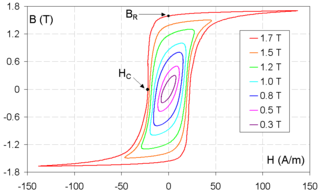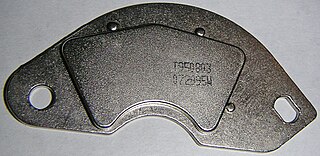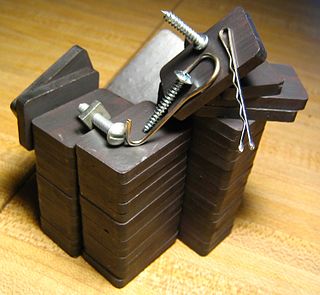Related Research Articles

In physics and materials science, the Curie temperature (TC), or Curie point, is the temperature above which certain materials lose their permanent magnetic properties, which can (in most cases) be replaced by induced magnetism. The Curie temperature is named after Pierre Curie, who showed that magnetism was lost at a critical temperature.
Magnetostriction is a property of magnetic materials that causes them to change their shape or dimensions during the process of magnetization. The variation of materials' magnetization due to the applied magnetic field changes the magnetostrictive strain until reaching its saturation value, λ. The effect was first identified in 1842 by James Joule when observing a sample of iron.

Magnetic refrigeration is a cooling technology based on the magnetocaloric effect. This technique can be used to attain extremely low temperatures, as well as the ranges used in common refrigerators.
Remanence or remanent magnetization or residual magnetism is the magnetization left behind in a ferromagnetic material after an external magnetic field is removed. Colloquially, when a magnet is "magnetized", it has remanence. The remanence of magnetic materials provides the magnetic memory in magnetic storage devices, and is used as a source of information on the past Earth's magnetic field in paleomagnetism. The word remanence is from remanent + -ence, meaning "that which remains".

An amorphous metal is a solid metallic material, usually an alloy, with disordered atomic-scale structure. Most metals are crystalline in their solid state, which means they have a highly ordered arrangement of atoms. Amorphous metals are non-crystalline, and have a glass-like structure. But unlike common glasses, such as window glass, which are typically electrical insulators, amorphous metals have good electrical conductivity and can show metallic luster.

Coercivity, also called the magnetic coercivity, coercive field or coercive force, is a measure of the ability of a ferromagnetic material to withstand an external magnetic field without becoming demagnetized. Coercivity is usually measured in oersted or ampere/meter units and is denoted HC.

A neodymium magnet (also known as NdFeB, NIB or Neo magnet) is a permanent magnet made from an alloy of neodymium, iron, and boron to form the Nd2Fe14B tetragonal crystalline structure.
Magnetic semiconductors are semiconductor materials that exhibit both ferromagnetism and useful semiconductor properties. If implemented in devices, these materials could provide a new type of control of conduction. Whereas traditional electronics are based on control of charge carriers, practical magnetic semiconductors would also allow control of quantum spin state. This would theoretically provide near-total spin polarization, which is an important property for spintronics applications, e.g. spin transistors.

Magnetic force microscopy (MFM) is a variety of atomic force microscopy, in which a sharp magnetized tip scans a magnetic sample; the tip-sample magnetic interactions are detected and used to reconstruct the magnetic structure of the sample surface. Many kinds of magnetic interactions are measured by MFM, including magnetic dipole–dipole interaction. MFM scanning often uses non-contact AFM (NC-AFM) mode.

A ferrite is a ceramic material made by mixing and firing iron(III) oxide with one or more additional metallic elements, such as strontium, barium, manganese, nickel, and zinc. They are ferrimagnetic, meaning they are attracted by magnetic fields and can be magnetized to become permanent magnets. Unlike other ferromagnetic materials, most ferrites are not electrically conductive, making them useful in applications like magnetic cores for transformers to suppress eddy currents. Ferrites can be divided into two families based on their resistance to being demagnetized.
Exchange bias or exchange anisotropy occurs in bilayers of magnetic materials where the hard magnetization behavior of an antiferromagnetic thin film causes a shift in the soft magnetization curve of a ferromagnetic film. The exchange bias phenomenon is of tremendous utility in magnetic recording, where it is used to pin the state of the readback heads of hard disk drives at exactly their point of maximum sensitivity; hence the term "bias."
A half-metal is any substance that acts as a conductor to electrons of one spin orientation, but as an insulator or semiconductor to those of the opposite orientation. Although all half-metals are ferromagnetic, most ferromagnets are not half-metals. Many of the known examples of half-metals are oxides, sulfides, or Heusler alloys. Types of half-metallic compounds theoretically predicted so far include some Heusler alloys, such as Co2FeSi, NiMnSb, and PtMnSb; some Si-containing half–Heusler alloys with Curie temperatures over 600K, such as NiCrSi and PdCrSi; some transition-metal oxides, including rutile structured CrO2; some perovskites, such as LaMnO3 and SeMnO3; and a few more simply structured zincblende(ZB) compounds, including CrAs and superlattices. NiMnSb and CrO2 have been experimentally determined to be half-metals at very low temperatures.
Gallium manganese arsenide, chemical formula (Ga,Mn)As is a magnetic semiconductor. It is based on the world's second most commonly used semiconductor, gallium arsenide,, and readily compatible with existing semiconductor technologies. Differently from other dilute magnetic semiconductors, such as the majority of those based on II-VI semiconductors, it is not paramagnetic but ferromagnetic, and hence exhibits hysteretic magnetization behavior. This memory effect is of importance for the creation of persistent devices. In (Ga,Mn)As, the manganese atoms provide a magnetic moment, and each also acts as an acceptor, making it a p-type material. The presence of carriers allows the material to be used for spin-polarized currents. In contrast, many other ferromagnetic magnetic semiconductors are strongly insulating and so do not possess free carriers. (Ga,Mn)As is therefore a candidate as a spintronic material.
In physics, the Landau–Lifshitz–Gilbert equation, named for Lev Landau, Evgeny Lifshitz, and T. L. Gilbert, is a name used for a differential equation describing the precessional motion of magnetization M in a solid. It is a modification by Gilbert of the original equation of Landau and Lifshitz.
In its most general form, the magnetoelectric effect (ME) denotes any coupling between the magnetic and the electric properties of a material. The first example of such an effect was described by Wilhelm Röntgen in 1888, who found that a dielectric material moving through an electric field would become magnetized. A material where such a coupling is intrinsically present is called a magnetoelectric.
In magnetism, single domain refers to the state of a ferromagnet in which the magnetization does not vary across the magnet. A magnetic particle that stays in a single domain state for all magnetic fields is called a single domain particle. Such particles are very small. They are also very important in a lot of applications because they have a high coercivity. They are the main source of hardness in hard magnets, the carriers of magnetic storage in tape drives, and the best recorders of the ancient Earth's magnetic field.

James John Miles is a retired Professor of Computer Engineering in the School of Computer Science at the University of Manchester where he previously was head of the school and a member of the Nano Engineering & Storage Technology Research Group (NEST).

In condensed matter physics, an Arrott plot is a plot of the square of the magnetization of a substance, against the ratio of the applied magnetic field to magnetization at one fixed temperature(s). Arrott plots are an easy way of determining the presence of ferromagnetic order in a material. They are named after American physicist Anthony Arrott who introduced them as a technique for studying magnetism in 1957.
Exchange spring media is a magnetic storage technology for hard disk drives that allows to increase the storage density in magnetic recording. The idea, proposed in 2004 by Suess et al., is that the recording media consists of exchange coupled soft and hard magnetic layers. Exchange spring media allows a good writeability due to the write-assist nature of the soft layer. Hence, hard magnetic layers such as FePt, CoCrPt-alloys or hard magnetic multilayer structures can be written with conventional write heads. Due to the high anisotropy these grains are thermally stable even for small grain sizes. Small grain sizes are required for high density recording. The introduction of the soft layer does not decrease the thermal stability of the entire structure if the hard layer is sufficiently thick. The required thickness of the hard layer for best thermal stability is the exchange length of the hard layer material. The first experimental realization of exchange spring media was done on Co-PdSiO multilayers as the hard layer which was coupled via a PdSi interlayer to a FeSiO soft layer.
Chromium telluride (Cr2Te3) is an inorganic chemical compound. It is composed of the chromium(III) cation and the telluride anion. It has a shadowy gray color, and has a hexagonal crystal structure.
References
- ↑ Alves, C.S.; Colman, F.C.; Foleiss, G.L.; Vieira, G.T.F.; Szpak, W. (November 2013). "Numerical simulation and design of a thermomagnetic motor". Applied Thermal Engineering. 61 (2): 616–622. doi:10.1016/j.applthermaleng.2013.07.053.
- ↑ Karle, Anton (October 2001). "The thermomagnetic Curie-motor for the conversion of heat into mechanical energy". International Journal of Thermal Sciences. 40 (9): 834–842. doi:10.1016/S1290-0729(01)01270-4.
- ↑ Trapanese, Marco (April 2011). "A dq axis theory of the magnetic, thermal, and mechanical properties of Curie motor" (PDF). Journal of Applied Physics. 109 (7): 07E706. Bibcode:2011JAP...109gE706T. doi:10.1063/1.3562505. hdl: 10447/80505 . ISSN 0021-8979.
- ↑ Edison, T. A., "Pyromagnetic Motor", US Patent No. 380,100; Patented March 27, 1888.
- 1 2 Bessa, C.V.X.; Ferreira, L.D.R.; Horikawa, O.; Gama, S. (December 2018). "On the relevance of temperature, applied magnetic field and demagnetizing factor on the performance of thermomagnetic motors". Applied Thermal Engineering. 145: 245–250. doi:10.1016/j.applthermaleng.2018.09.061. S2CID 117682356.
- ↑ Gama, Sergio; Ferreira, Lucas D. R.; Bessa, Carlos V. X.; Horikawa, Oswaldo; Coelho, Adelino A.; Gandra, Flavio C.; Araujo, Raul; Egolf, Peter W. (2016). "Analytic and Experimental Analysis of Magnetic Force Equations". IEEE Transactions on Magnetics. 52 (7): 1–4. doi:10.1109/tmag.2016.2517127. S2CID 21094593.
- ↑ Ferreira, L.; Bessa, C.; Silva, I.; Gama, S. (2013). Green Design, Materials and Manufacturing Processes. pp. 107–111. doi:10.1201/b15002-23. ISBN 978-1-138-00046-9.
- 1 2 Bessa, C. V. X.; Ferreira, L. D. R.; Horikawa, O.; Monteiro, J. C. B.; Gandra, F. G.; Gama, S. (2017). "On the influence of thermal hysteresis on the performance of thermomagnetic motors". Journal of Applied Physics. 122 (24): 244502. Bibcode:2017JAP...122x4502B. doi:10.1063/1.5010356.
- ↑ Martin, Thomas Commerford; Wetzler, Joseph (1891). The electric motor and its applications. New York: W. J. Johnston. pp. 272–278.
- ↑ Murakami, K.; Nemoto, M. (1972). "Some experiments and considerations on the behavior of thermomagnetic motors". IEEE Transactions on Magnetics. 8 (3): 387–389. Bibcode:1972ITM.....8..387M. doi:10.1109/tmag.1972.1067406.
- ↑ Andreevskii, K. N.; Mandzhavidze, A. G.; Margvelashvili, I. G.; Sobolevskaya, S. V. (September 1, 1998). "Investigation of the thermodynamic and physical characteristics of a thermomagnetic engine with a gadolinium working element". Technical Physics. 43 (9): 1115–1118. Bibcode:1998JTePh..43.1115A. doi:10.1134/1.1259144. ISSN 1063-7842. S2CID 121369732.
- ↑ Egolf, Peter W.; Kitanovski, Andrej; Diebold, Marc; Gonin, Cyrill; Vuarnoz, Didier (2009). "Magnetic power conversion with machines containing full or porous wheel heat exchangers". Journal of Magnetism and Magnetic Materials. 321 (7): 758–762. Bibcode:2009JMMM..321..758E. doi:10.1016/j.jmmm.2008.11.044.
- ↑ Smart Materials Structures of Systems, Allied Publishers, ISBN 8170239583, pages 23–25.
- ↑ Kishore, Ravi Anant; Davis, Brenton; Greathouse, Jake; Hannon, Austin; Emery Kennedy, David; Millar, Alec; Mittel, Daniel; Nozariasbmarz, Amin; Kang, Min Gyu (2019). "Energy scavenging from ultra-low temperature gradients". Energy & Environmental Science. 12 (3): 1008–1018. doi:10.1039/C8EE03084G. ISSN 1754-5692. S2CID 104331548.
- Von Tunzelmann, George William (1902). Electricity in modern life. New York: P. F. Collier & Son. pp. 383–388.